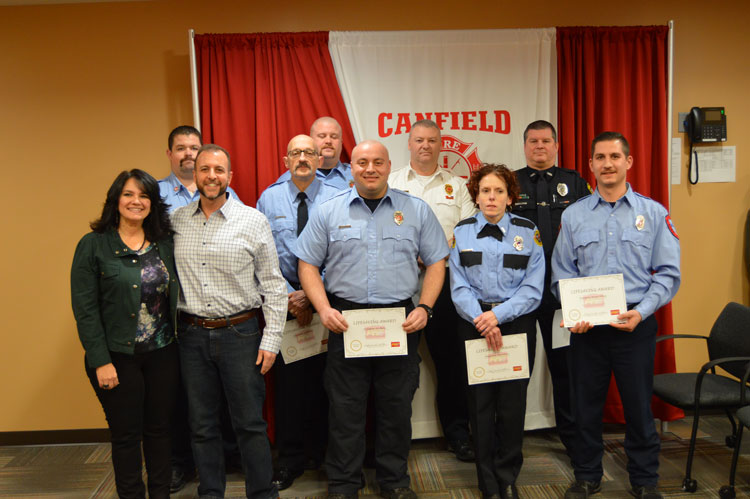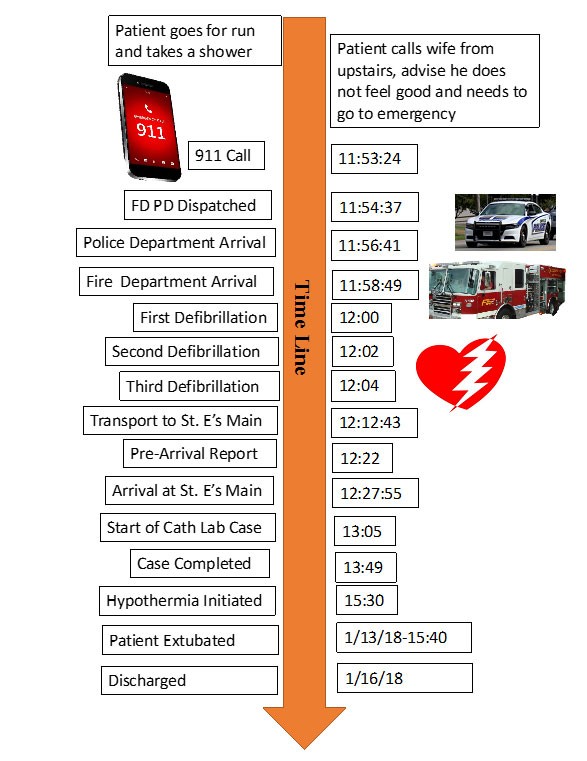

From left : Patient John Centofanti, FF/Medic Brian Blevins, FF/EMT Joe Morell, FF/Medic Shane Uhrain, FF/EMT Gio Melia, Capt Troy Kolar, Dispatcher Pam Vizzini, Officer Mark Meshula, FF/EMT Shawn Fiffick
By Conner O’Halloran, Troy Kolar, Robert Tieche Jr., and Matthew Ozanich
On the morning of January 11, 2018, Cardinal Joint Fire District (AKA Canfield (OH) Fire Department) and Canfield Police Department employees reported to work just like any other day. The two agencies are separate governmental municipalities: the fire district is comprised of Canfield Township and Canfield City, whereas the police department is only comprised of Canfield City. Despite the political separation, both departments work seamlessly together, so well in fact that the average citizen does not even realize there is a separation.
Canfield Police Department is a full-time police department that regularly responds with the fire department on medical emergencies. In each marked police car, there is a jump kit consisting of a tourniquet, naloxone kit, and an automated external defibrillator (AED). The police department trains annually with the fire department on using this equipment.
RELATED
Improving Cardiac Arrest Outcomes with CardioCerebral Resuscitation
Podcast: Firemedically Speaking: The Rialto Fire Resuscitation Evolution
Comparing Manual and Mechanical Chest Compressions
The Importance of CCR Training for Volunteer Firefighters
Cardinal Joint Fire District (CJFD) is a three-station operation that serves 25 square miles of the City of Canfield and Township of Canfield, a population of approximately 20,000 people. CJFD responds with Advance Life Support (ALS) engines and ambulances to all medical emergencies, fire emergencies, etc. in Canfield. CJFD is staffed around the clock year-round with six personnel (two at each station).
On duty for the fire district that morning was the following: Squad 101, an ALS- equipped light-rescue fire engine. The company officer on Squad 101 was Firefighter/Paramedic Brian Blevins and Firefighter/EMT Joe Morell Sr. Working at station two that day, cross-manning a twin to Squad 101 and ALS-equipped ambulance Medic 102, were officer Firefighter/Paramedic Shane Uhrain and Firefighter/EMT Shawn Fiffick. Finally, working at station three that day, on an ALS-equipped 75-foot quint, were shift officer Captain/Paramedic Troy Kolar and Firefighter/EMT Giovambattista Melia. Canfield Police employees associated with this call included the call taker Dispatcher Pam Vizzini and Officer Mark Meshula.

On January 11, 2018 at 11:53:24 in the morning, Canfield police received a 911 call from an address in the city. The caller reported that her husband was suffering from chest pain. Just about one minute after receiving the call, Canfield Dispatcher Pam Vizzini promptly dispatched Canfield Police Officer Mark Meshula, Canfield Fire Squad 101, and Canfield Fire Medic 102. At 11:56:51, Officer Meshula arrived on scene and updated Dispatch that the patient’s condition had deteriorated. Meshula promptly initiated life-saving continuous chest compressions while instructing the wife to flag down the fire department. Upon the arrival of Squad 101 (11:58:49) and Medic 102 (11:59:39), fire department personnel went right to work using Advanced Cardiac Life Support (ACLS) care and the Lucas Chest Compression System™. After three manual defibrillations (12:00, 12:02, and 12:04), the patient was converted into sinus bradycardia with successful return of spontaneous circulation (ROSC). The patient had spontaneous breathing and was promptly extricated and transported to the emergency room. Transport was initiated at 12:12:43, prearrival report and EKG transmission at 12:21 (below), and hospital arrival was at 12:27:55, just about forty minutes after receiving the original 911 call.
Upon arrival at the hospital, EMS was met by emergency room nurses, physicians, and a cardiologist. The patient presented suspected of an inferior myocardial infarction, based on information received from EMS on the prearrival verbal report and prehospital EKG. At 13:03, the cath team began and their case was completed 13:49, just two hours after the initial 911 call was received. Postcardiac-arrest hypothermia protocol was initiated and the patient was transferred to the Cardiovascular Intensive Care Unit (CICU). The patient underwent rewarming on January 12 at 17:12 and was extubated about one day later on January 13 at 15:40. On January 16, he was discharged back home.
On February 26, 2018, the patient, John Centofanti attended the CJFD Fire Board Meeting and personally thanked all of the personnel involved in the call. Each crew member was awarded with a lifesaving award and recognition. John reports that his cardiac rehabilitation is ongoing, and he is grateful to live in such a great city. He specifically wrote a letter of gratitude to the fire board, which was read verbatim at the meeting by Board Chairman John Morvey.

From left: FF/Medic Brian Blevins, FF/EMT Joe Morell, FF/Medic Shane Uhrain, FF/EMT Gio Melia, Capt Troy Kolar, Dispatcher Pam Vizzini, Officer Mark Meshula, FF/EMT Shawn Fiffick
CASE DISCUSSION
Cardiac arrest outside of the hospital has a low and variable survivability rate. According to the Institute of Medicine, survivability to discharge from the hospital can be as low as or lower than six percent. This national average is complicated by diverse availability of various levels of and access to prehospital emergency medical care. Time is critical in a cardiac arrest event. Specifically, according to the American Heart Association 2015 guidelines, every one minute without chest compression increases the likelihood of mortality by 10 percent. Once cardiac arrest is recognized, it requires a fast, coordinated response to be successful.
This case is a perfect example of maintaining working relationships with patrol officers. Canfield police regularly respond on medical emergencies with the fire district. Patrol officers by definition, are on the road and able to quickly arrive on scene. This allows for immediate chest compressions, which, as AHA has clearly proven, can make the difference between a patient being discharged neurologically intact or not. Additionally, having the police cruiser on scene accomplishes a simple yet time-saving task: it marks the address of the emergency. This saves additional responders from seeking out house addresses, which is not always easy or reliable. Finally, having a patrol officer regularly on these scenes helps stabilize the scene and make working conditions significantly more manageable for EMS providers.
Another takeaway point from this case is the importance of having certified emergency medical dispatchers (EMD) answering 911 calls. The algorithms set by EMD protocols have the dispatcher focus the caller, provide basic but lifesaving initial care, and offer simple instructions that might otherwise be forgotten in the emergency setting. These procedures, which are well established by the International Academy of Emergency Medical Dispatchers, include unlocking the front door, turning on a porch light for scene identification, and putting away pets, all of which can expedite patient access. In the case of a cardiac arrest, it allows for unimpeded access to the patient. Focusing the caller, which is easier said than done in some cases, can begin to stabilize the scene. A calm caller is much more reliable and helpful, which enables emergency responders to obtain important information concerning medications, medical history and so on. Basic life support can make the difference in patient outcome, so the key points from this case are early identification of cardiac arrest and the initiation of life-saving chest compressions.

From the hospital standpoint, they had an early activation of their resources because of the detailed EMS verbal report prior to EMS arrival at the emergency room. Additionally, Firefighter Paramedic Uhrain transmitted the patient’s EKG (above) to the receiving facility. Because of the detailed report, the hospital had a cardiologist, ED team, and Cath team waiting for the ambulance. This allowed for a fast transition from the emergency room to cardiology to recovery in just about two hours.
*
This case is a rare case that represents a perfect situation where everything worked. All too often, 911 is delayed and by the time responders arrive, the patient has been down for too long. Resuscitation is attempted and eventually declared unsuccessful. Depending on protocols, EMS personnel generally cease resuscitation efforts and pronounce the patient deceased at that time. Thankfully, that did not happen in this case. Not only did the EMS crew achieve spontaneous circulation but the patient walked out of the hospital with no neurologic deficits.
REFERENCES
American Heart Association 2015 Guidelines
Clawson, J. J. , Dernocoeur, K. B. , & Murray, C. (2015). Principles of Emergency Medical Dispatch (6th ed. ). Salt Lake City: Priority Press.
Institute of Medicine. (2015, June). Strategies to Improve Cardiac Arrest Survival.
Conner O’Halloran, MS, NRP, OFO, is a captain and the training officer for the Cardinal Joint Fire District. He completed a masters degree in Emergency Management from Eastern Kentucky University. He has been a nationally registered paramedic for 10 years, has taught for Youngstown State University in several EMT and paramedic classes, and is the medical education officer for the Western Reserve Joint Fire District. He is also a credentialed Ohio fire officer.
Robert Tieche Jr., EMT-P, OFO is a captain and the EMS director for the Cardinal Joint Fire District. Captain Tieche also is a credentialed Ohio fire officer. He has been a leader in implementing the Cardinal Joint Fire District ambulance program.
Troy Kolar, EMT-P, OFO; is a captain and credentialed Ohio fire officer. He regularly teaches firefighter training classes for the Mahoning County Career and Technical Institute. He is the founder and chairman of First Responders First, a nonprofit company focused on raising money for first responders and educating the public on roadway safety around emergency scenes.

